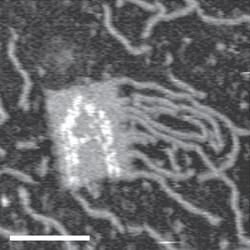September 6, 2007 feature
Molecules autonomously propelled by polymerizing DNA strands

Scientists from the California Institute of Technology have fabricated a motor that runs autonomously, and is powered only by the free energy of DNA hybridization. The molecular motor was inspired by bacterial pathogens such as Rickettsia rickettsii that propel themselves through host cells by polymerizing protein “comet tails.” The synthetic mimic operates by polymerizing a double-helical DNA tail out of metastable DNA hairpins (a pattern named for its 180-degree turn).
Representing the Departments of Bioengineering, Computer Science, Computation & Neural Systems, and Applied & Computational Mathematics at Caltech, researchers Suvir Venkataraman and colleagues have published their results in a recent issue of Nature Nanotechnology.
In contrast to previous synthetic molecular motors, the current motor is powered by non-covalent interactions and operates freely in solution without a substrate.
“Propulsive locomotion is achieved by harnessing a hybridization chain reaction (HCR), in which metastable DNA hairpins polymerize upon encountering a target molecule,” coauthor Niles Pierce told PhysOrg.com. “Strikingly, the propelled DNA strand remains firmly in contact with the growing polymer while performing successive handshakes with inserting hairpins.”
In geometric mimicry of Rickettsia’s comet tail, the researchers used atomic force microscopy to demonstrate patterned polymerization on one side of a rectangular DNA origami (a method of constructing nanoscale objects recently invented by coauthor Paul Rothemund). The researchers do not yet know whether the polymerization of nanoscale nucleic acid monomers can propel microscale objects freely through solution in more complete functional mimicry of Rickettsia.
“This study provides a proof of principle that DNA hybridization can be used to power autonomous molecular locomotion,” said Pierce. “Researchers at the NSF Center for Molecular Cybernetics, of which our team is a part, are now working to develop logical walkers that can work cooperatively and respond to their environment. It is possible that synthetic molecular motors may one day be routinely used in medicine, basic research, and manufacturing.”
Citation: Venkataraman, Suvir, Dirks, Robert M., Rothemund, Paul W. K., Winfree, Erik, and Pierce, Niles A. “An autonomous polymerization motor powered by DNA hybridization.” Nature Nanotechnology, Vol, 2, August 2007, 490-494.
Copyright 2007 PhysOrg.com.
All rights reserved. This material may not be published, broadcast, rewritten or redistributed in whole or part without the express written permission of PhysOrg.com.





















